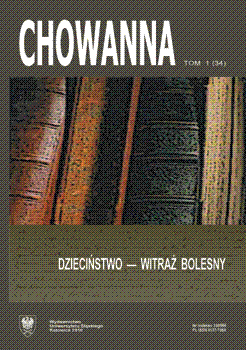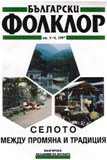


Keywords: childhood; child value; modernity
The article presents some thoughts on childhood and child value in a modern world. We are living in times when there is a chaos of values. Old ones are important no longer whereas the new, often artificially created are not understood, related to culture and other factors. The border between what is proper and legal and what is immoral. But the value of a child should not be undermined. Relations with a child pictured the idea of humanism, man to man relation.
More...
Keywords: attachment; parental practises; rejection by peers; externalization disorders
Among children rejected by their peers there is a large group that is characterized by externalization problems. They are resulted from parental practices and the care of children in the first years of their life, both of which make impossible for them to create safe attachment. Relations, between children emotional and social development disorders and conditions of the development in family environment, are discussed in this article. It has been pointed out that there is a necessity to prevent rejection of a child by its peers, by supporting parents in fulfilling their educational and caring functions.
More...
Keywords: ill child; family; neglect
Child that suffers from illness is in a difficult situation. His special needs must be met by parents, he is completely dependent on them on various ways. Parents attitudes toward an ill child are different, coming from cultural and social context. Neglect of health care by parents is a phenomenon that depends on some factors, which are described in the article.
More...
Keywords: Janusz Korczak; childhood; child harm; child rights
The article, in the face of some reflections on various forms of harm still experiencing by contemporary children despite some regulations and law protection. The author says that a lot of forms of a child harm can be found in the past — they are changing in their context, intensity, and places of occurring, but not their nature and their damaging consequences on child development. Janusz Korczak is reminded — his interest of a child and his sensitivity to difficult situations of children living in his time. There are some of Korczak’s and other authors texts quoted, in which child harm is described; examples of inhuman child work and violent discipline. The author emphasis Korczak’s genius of listening to children and painting a painfull pictures of child life. Showing the picture of a childhood from the beginning of XX century, the authors asks the question: does the picture fit to a child from the beginning of XXI century?! When can we write a book “childhood — a happy picture”?
More...
Keywords: children rejected by their peers; risk group; control of emotions; support of development
Childhood full of painful experiences is familiar to these children who are rejected by their peers. Because of restricted contacts with other people they have few opportunities to develop their social, emotional and cognitive competences. This article presents the theoretical assumption of the authorized programme of supporting the psychosocial development of children rejected by their classmates. This programme deals with creating conditions for the development of emotional self‑control. The detailed goals which enable developing this skill and the ways to achieve them are also presented in this article.
More...

Keywords: parents; child; corporal punishment
The paper analyzes parents’ opinions about the use of corporal punishment of children. The subjects’ arguments for and against beating children have been organized according to the types of justifications they have provided. The opinions expressed by these parents concern their personal experiences and relationships with their children.
More...
Keywords: violence against children; history of child abuse; social interest of child abuse; development of research of child abuse
Article presents both some forms of child abuse that exists in social history and first forms of protection of child abuse. The development of the social interest of child maltreatment is also described. The third mainstream of the article is the development of scientific research of the problem; since the first description of the phenomenon of Ambroise Tardieu, through discoveries of medicians of mid XX century (Caffey and Kempe) till the beginning of undertaking the problem by polish researchers.
More...
Keywords: infanticide; child abuse; childhood; history of abuse; democracy; child rights
The article is an attempt to find, through the analysis of history of child abuse and the history of social activities against this phenomenon, the crucial factors that stand behind the change of situation of children in modern world and their better treatment. Through ages child was seen as an object that can be scarify in the name of adult, community, state welfare. The situation of a child changed mainly in XIX century, what was supported by various processes, among which the development of social philosophy of equality, democracy and human right seems to be the most fundamental
More...
Keywords: child abuse; mandatory reporting; bystander effect; the role of a school in child protection
In this article several aspects referring to bystanding child abuse and failure to provide appropriate help to victims were discussed. The author mentions motivations and situational factors as well as personal characteristics influencing human readiness to offer help. The article presents selected theories related to intervention in case of violence and cites the results of research on detterents discouraging teachers and other professionals from intervention to abused children.
More...
Keywords: positive prevention; resiliency; children and teenagers from families with alcohol problem
This article pays attention to the need of changing, a very popular in Polish pedagogical theory and practice preventive approach, which focuses on diagnosing and eliminating the influence of risk factors that are threatening for children and teenagers. In Polish schools there is a lack of positive preventive practice effects, based on strength and recourses of children, especially for children from the families with alcohol problems. The number of children coming from this kind of families is the biggest in the population of threatened children. As for the children, using the idea of resiliency would be especially promising for designing preventive effects having the character of positive prevention. This conception explains how it is possible to support the process of coping with adversities, achieving additional protection by an individual, developing the skills of coping with disruptions resulting from a stressful event.
More...


Taking the example of the Bulgarian mountain village of Raduil, this article attempts to describe the physical changes of a village resulting from the policy of the socialist state after 1944. The man-made environment of the village was the physical realization of the Party’s ideological concepts of the political, economic, social, and cultural life of the population. In the 1930’s, Raduil had been the central village of a larger independent rural community. The population had made a living from forestry and agriculture, and its flourishing timber production had brought moderate wealth to the village. After the Communist takeover, the village lost its autonomy, and as a result of the nationalization of the forests and the collectivization of agriculture, the entire economic structure changed fundamentally. The ideology-based concepts of urban construction and planning and the corresponding laws and regulations also laid the foundations for the physical transformation of villages, both in the overall plan and in the details of house construction. As in many other Bulgarian villages, the spatial structure of the village of Raduil still displays the three functional areas typical of socialist planning: the “zone for production”, the “zone for social life and public assistance”, and the “zone for dwelling”. After 1989, some of these “socialist structures” lost their functions and many institutions were dissolved or destroyed, among them the cooperative farm (TKZS). Private shops, pubs, workshops, and agricultural enterprises were established throughout the village, gradually breaking up the functional divisions and the spatial concentration of social life imposed by 40 years of socialist village planning.
More...
After the establishment of one-party rule in the late 1940’s, the Bulgarian Communist Party started an aggressive campaign directed against religion and the church. Part of the Party’s atheist policy was to eliminate the religious feasts and practices of the people and to replace them with a whole set of new socialist holidays and customs, which were expected to contribute to the molding of the new “socialist personality”. In accordance with this official policy, the holiday of St. Mary’s Assumption (August, 15), celebrated as a parish fair (sabor) in the mountain village of Raduil, which is presented as an example, was turned into a secular Day of the cooperative Worker. It underwent a number of transformations, for example the abolition of the religious rituals and their replacement by “progressive” traditional elements considered adequate for the socialist order, the inclusion of new socialist elements, and the alteration of the entire feast’s meaning. The holiday was utilized for the shaping of the “new socialist man” but it was also instrumentalized for the self-presentation of the local elite. However, the changes were not accepted; instead, the intentions of the local authorities were countered by the unwillingness of the villagers to comply. In the course of time, they developed cultural strategies in order to reduce the discrepancies between the imposed model and their own needs, like giving preference to the private sphere and moving religious rituals from the public to the private arena. In the end, the holiday had turned into a conglomerate of socialist and traditional elements and established itself somewhere “in tile middle”, between the pressure “from above” and the reactions “from below”.
More...

This article focuses on the pre-socialist processes of transformation in Balkan societies from the beginning of national independence to World War II. The development in the post-Ottoman Balkan states was characterized by a relatively high speed of transformation (“Westernization”, “Europeanization”) in nearly all sectors of society. In an attempt to eliminate the Ottoman legacy and the traditional habits of the Balkan peasants, the “modernizers” started a radical program to build a modern state – irrespective of the social costs for the vast majority of the population. The lack of traditional Christian institutions under Ottoman rule was replaced by an abundance of new state-oriented institutions which were established according to Western models but functioned according to Oriental practice. In the course of this post-Ottoman institutional revolution, the traditional Balkan village as the most important multifunctional institution of Christian peasants under Ottoman rule was totally transformed. But the speed of mentality change lagged far behind the speed of state institutional reform. The outcome of this time lag was the degeneration of the village to a transmission belt of the new central power, and the economic as well as political marginalization of the peasants. The author argues that the changes in political, legal, and economic institutions after the establishment of nation states were rapid, irreversible, and strongly influenced by foreign models. However, they did not sufficiently take into account the low capacity of change in the predominantly agrarian population. The outcome was not a modern capitalist society but a mixture of pre-capitalist and capitalist (market and non-market) elements in a highly fragmented society. The Balkan village fell into a state of agony long before the socialist regimes began to impose their models of forced industrialization at all costs. A reorientation of post-socialist societies to pre-socialist paths of development is neither possible nor is it desirable.
More...